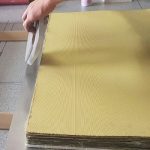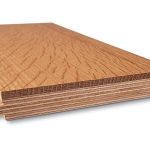Global Engineered Wood Market Poised to Reach nearly USD 572 Billion by 2032, Driven by Sustainable Construction & Furniture Demand
Engineered wood is gaining traction globally as demand for sustainable, cost-efficient, and versatile building materials rises. Composed of layers, particles, strands, or veneers of wood bonded with adhesives, engineered wood (including plywood, MDF, CLT, LVL, OSB, and others) is being increasingly used in residential, non-residential, furniture, flooring, and packaging applications. Regulatory push toward green building, concerns over deforestation, and the shift from solid wood toward composite alternatives are major trends reshaping the market’s future through 2034.
Our comprehensive Engineered Wood Market report is ready with the latest trends, growth opportunities, and strategic analysis. View Sample Report PDF.
Key Takeaways
- The engineered wood market is estimated at USD 354.40 billion in 2023.
- Forecast to reach about USD 572 billion by 2032, extrapolating from Vantage data and similar reports using a CAGR of 6.17%.
- Plywood is the dominant product type by revenue in 2024; Medium Density Fiberboard (MDF) and CLT are among the fastest growing.
- The construction application holds the largest share, while furniture / interior applications are projected to grow faster.
- The residential end-use industry had the largest share in 2024; non-residential (commercial, institutional) segments are expected to accelerate.
- Regionally, Asia Pacific dominated in revenue in 2024; North America is expected to register among the fastest regional CAGRs over the forecast period.
Premium Insights
There is a clear pivot toward engineered wood solutions as architects, builders, and regulators seek sustainable alternatives to solid wood, concrete, and steel. Technologies such as cross-laminated timber (CLT) and laminated veneer lumber (LVL) are being adopted for mid-rise and even tall structures, offering both structural performance and carbon benefits. Furniture and interior segments are leveraging engineered wood for its stability, aesthetic flexibility, and lower cost. Simultaneously, manufacturers are investing in low VOC adhesives, waste utilization (wood residues), and certifications (FSC, PEFC) to meet environmental standards and consumer preferences, boosting demand especially in developed markets.
Market Size & Forecast
- Revenue in 2024: USD 354.40 billion.
- Forecast for 2032: USD 572 Billion
- CAGR (2024-2034): 6.17%
The engineered wood market is moderately fragmented. There are many players globally—from large multi-nationals to smaller regional manufacturers. Competitive advantages derive from access to raw wood resources (softwood vs hardwood), technology (e.g., CLT and LVL production, adhesive chemistry), certifications, cost of logistics, sustainability credentials, and proximity to construction and furniture manufacturing hubs. Regions with forest resources, as well as strong regulation favoring eco-friendly materials, skew toward larger, more efficient producers. Barriers include raw material constraints, regulatory compliance costs, and competition from substitutes (solid wood, steel, plastics).
For Engineered Wood Market Research Report and updates detailed: View Full Report Now!
Type Insights
The engineered wood market is segmented by type into plywood, laminated veneer lumber (LVL), oriented strand board (OSB), cross-laminated timber (CLT), and others. Plywood remains dominant due to its versatility in furniture, flooring, and structural applications. Meanwhile, CLT and OSB are gaining traction in sustainable construction, offering high strength, cost-effectiveness, and eco-friendly benefits. Increasing demand for modular housing and green building certifications is driving adoption across multiple engineered wood types, strengthening their role in modern construction and design.
Application Insights
Based on application, the engineered wood market covers residential, commercial, and industrial sectors. Residential construction holds the largest share, driven by rising housing demand and consumer preference for durable yet cost-effective materials. Commercial applications, including offices, retail, and hospitality, are expanding rapidly as sustainable building standards gain momentum. Industrial usage is also growing in packaging, scaffolding, and prefabrication activities. Engineered wood offers superior durability, design flexibility, and environmental advantages, positioning it as a preferred material across diverse applications globally.
Regional Insights
North America Engineered Wood Market Trends
North America is expected to see strong growth over the forecast period, driven by increased adoption of mass timber (CLT, LVL) in mid-rise building codes, green building regulations, and renovation of aging housing stock. Consumer awareness of sustainability, and regulations or incentives tied to carbon footprint are pushing engineered wood adoption. The presence of key manufacturers, good forest resources, and access to capital enable technology deployment. However, supply of raw wood, costs of transport, and certification mounting costs are challenges.
Europe Engineered Wood Market Trends
Europe continues to lead in engineered wood use per capita, with strong regulations favoring low-carbon building materials, and several countries adopting mass timber codes. Germany, Scandinavia, Austria, Switzerland, and others are centers of innovation, especially for CLT, LVL, and in prefabricated panels. Projects combining aesthetics and sustainability—public buildings, residential complexes—use engineered wood increasingly. However, regulatory complexity (codes, fire safety, adhesives) and raw material sourcing (sustainable certification) are important factors.
Asia Pacific Engineered Wood Market Trends
Asia Pacific dominated global revenue in 2024, motivated by rapid urbanization, burgeoning construction activity, rising incomes, and government pushes for affordable housing and sustainable development. Countries like China, India, Southeast Asia are major markets for plywood, MDF, OSB etc. Furniture manufacturing is robust. Also, investment in prefabricated structures is rising. But challenges include raw material supply, quality control, regulatory variation, and environmental concerns. Nevertheless, this region offers the largest volume growth prospects.
Latin America Engineered Wood Market Trends
Latin America remains less mature but promising. Countries with abundant forestry resources (Brazil, Chile) provide both raw materials and potential production hubs. Demand domestically is growing with infrastructure and housing development, but challenges include logistics (transport, access), certification, environmental concerns (deforestation), and capital for modern engineered wood mills. Export markets may be significant for Latin American producers. Non-residential construction and furniture are key opportunity areas.
Middle East & Africa Engineered Wood Market Trends
MEA is a smaller share currently, but growth potential is rising, especially in the Gulf and in urbanizing African nations. Demand comes largely from residential projects, interior finishes, furniture, and public infrastructure. Imported engineered wood is common due to limited local production and forest supply. Regulatory standards, quality, and sustainability certifications are increasingly important. Challenges include steep import costs, climate (humidity, termites), and competition from other materials.
Key Engineered Wood Company Insights
Engineered Wood of Top Companies:
Some of the leading players identified in Vantage Market Research’s Engineered Wood report are:
- 84 Lumber Company
- Universal Forest Products, Inc.
- Louisiana-Pacific Corporation (LP)
- Norbord Inc.
- Huber Engineered Wood LLC
- Patrick Industries, Inc.
- Shenzhen Risewell Industry Co., Ltd.
- Celulosa Arauco y Constitución, S.A.
- Weyerhaeuser Company
- Georgia-Pacific Wood Products
These companies compete based on product range (plywood, MDF, CLT, etc.), quality, environmental certifications, production capacity, R&D, and their ability to serve both local and export markets. Many are expanding capacity, enhancing adhesives used, improving moisture and durability performance, and pursuing sustainability (forest stewardship, low VOC adhesives), to meet rising demand in construction and furniture applications.
Recent Developments
- In 2024, several engineered wood manufacturers launched new CLT-based mid-rise residential building projects in North America and Europe, coupled with significant investments to upgrade their adhesive technologies for lower VOC emissions. (E.g. Company announcements around CLT building certifications in Germany, Scandinavia; also U.S. suppliers enhancing low-formaldehyde MDF lines.)
- In 2025, demand for engineered wood surged in furniture and kitchen cabinetry markets in Asia Pacific, leading companies to invest in increased plywood and MDF production capacity to avoid supply constraints, while simultaneously partially shifting to sustainable sourcing and forestry certifications.
Engineered Wood Market Report Scope
This report by Vantage Market Research covers the global Engineered Wood market with a base year around 2023-2024, forecasting to about 2034, with extrapolations toward 2035. It includes segmentation by Product Type (including plywood, MDF, CLT, LVL, OSB, glulam, particle board, and others), by Application (construction, flooring, furniture, packaging, others), and by End-Use Industry (residential, non-residential). Geographic scope includes North America, Europe, Asia Pacific, Latin America, and Middle East & Africa. The report also examines competitive landscape, key company profiles, recent developments, drivers, restraints, opportunities, and challenges shaping market evolution.
Market Dynamics
Driver:
Growing awareness and regulation around sustainability, carbon footprints, and green building materials are major drivers. Engineered wood provides advantages over solid wood and traditional construction materials (steel, concrete) in terms of embodied carbon, renewable sourcing, and lighter weight. Increasing housing demand, urbanization, and preferences for prefabricated, modular, and aesthetically appealing design further support growth. Also, innovations in adhesives, moisture resistance, and certifications are reducing previous functional limitations.
Restraint:
There are several restraints: raw material supply inconsistencies (both quality and sustainably certified sources), high cost of advanced engineered wood products (CLT, LVL) compared to inexpensive substitutes, regulatory barriers (fire codes, building codes, safety standards) that sometimes lag product innovation, and competition from other building materials (steel, concrete, solid wood, plastics). Also, in some regions, lack of skilled labor, technical know-how, and infrastructure for engineered wood production limit penetration.
Opportunity:
Opportunities lie in the growing uptake of mass timber (CLT, glulam) for mid-rise and tall timber buildings, especially in Europe, North America, and Asia Pacific. Also, furniture, interior design, and cabinetry segments are expanding fast, especially in urban markets, driving demand for MDF, plywood, decorative panels. Advances in adhesives (low formaldehyde, low VOC), durability (moisture, termite resistance), and modular prefabrication methods can open new markets. Potential in emerging markets with rising income and construction activity is substantial.
Challenges:
Challenges include meeting stringent regulatory standards (fire safety, structural integrity), ensuring durability in varied climates (moisture, pests), controlling costs of adhesives and production, securing sustainable sources of wood and managing forest resources, maintaining moisture and dimensional stability, and overcoming market inertia from use of traditional materials. Logistics and transportation cost (wood is bulky and heavy) also add to cost burdens, especially in remote or import-dependent regions.
Global Engineered Wood Market Report Segmentation
- By Type: Plywood; Medium Density Fiberboard (MDF); Cross-Laminated Timber (CLT); Laminated Veneer Lumber (LVL); Oriented Strand Board (OSB); Glulam; Particle Board; Others.
- By Application: Construction; Flooring; Furniture; Packaging; Others.
- By Region: North America; Europe; Asia Pacific; Latin America; Middle East & Africa.
Frequently Asked Questions
- What was the size of the global engineered wood market in 2023?
USD 354.40 billion.
- What is the forecasted size by 2032?
USD 572 billion.
- What is the expected CAGR for 2024-2034?
6.17%
- Which product type dominates currently?
Plywood holds the largest share in 2024. MDF and CLT are among the fastest growing.
- Which application has the highest demand?
Construction dominates. Furniture and interior applications projected to grow faster.
- Which end-use industry holds majority share?
Residential sector currently leads; non-residential is catching up.
- Which region is the largest, and which will grow fastest?
Asia Pacific is the largest by revenue in 2024; North America among fastest growth regions.
- Who are the key players in engineered wood market?
Some leading companies include 84 Lumber, Universal Forest Products, LP Corporation, Norbord, Huber Engineered Woods LLC, Shenzhen Risewell, Celulosa Arauco y Constitución, Weyerhaeuser, Georgia-Pacific, etc.
![[Market Research Reports] – Research Google News Blog | VMR.Biz](https://www.vmr.biz/wp-content/uploads/2022/12/logo-removebg-preview.png)











